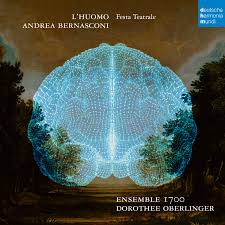BERNASCONI L'Huomo (Oberlinger)
View record and artist detailsRecord and Artist Details
Genre:
Opera
Label: Deutsche Harmonia Mundi
Magazine Review Date: 10/2024
Media Format: CD or Download
Media Runtime: 152
Mastering:
DDD
Catalogue Number: 19658 89209-2

Tracks:
| Composition | Artist Credit |
|---|---|
| Fanfare |
Tobias Buschdorf, Composer
Dorothee Oberlinger, Conductor Ensemble 1700 Lund |
| L'Huomo |
Andrea Bernasconi, Composer
Alice Lackner, Negiorea, Mezzo soprano Anna Herbst, Volusia, Soprano Dorothee Oberlinger, Conductor Ensemble 1700 Lund Florian Gotz, Cattivo Genio, Baritone Francesca Benitez, Buon Genio, Soprano Johanna Falkinger, Incosia, Soprano Maria Ladurner, Animia, Soprano Philipp Mathmann, Anemone, Countertenor Simon Bode, Amor Volubile; Amor Ragionevole, Tenor |
Author: David Vickers
Andrea Bernasconi was maestro di coro at Venice’s Ospedale della Pietà (1744 53) until he was recruited by Elector Maximilian III Joseph to supervise vocal music in Munich. Shortly afterwards, L’Huomo (1754) was commissioned by Margravine Wilhelmine of Brandenburg-Bayreuth to provide entertainment during a visit to Bayreuth by her younger brother from Berlin (ie Frederick the Great). She developed the scenario herself in French before it was altered into workable Italian by court poet Luigi Stampiglia. Female and male souls (Animia and Anemone) are deeply in love but targeted by an Evil Spirit (Cattivo Genio) and Fickle Love (Amor Volubile); they quarrel after Anemone falls victim to Lust (Volusia) and bemoans his mistake to Inconstancy (Incosia). The estranged couple receive counselling from a Benign Spirit (Buon Genio), Reason (Negiorea) and Rational Love (Amor Ragionevole) before they reconcile. Along the way, choruses of Infernal or Celestial Spirits chip in occasionally.
Bernasconi obliged his singers by incorporating several arias by Hasse and Galuppi, and Margravine Wilhelmine is attributed as the composer of two cavatinas for Buon Genio in scene 17. The festa teatrale premiered at the Margravine’s own new opera (inaugurated 1748). Now restored beautifully, the historic theatre is an UNESCO world heritage site. In a rare instance of serendipity, Ensemble 1700’s live recording was made during a run of staged performances in May 2023 at Bayreuth’s Markgräfliches Opernhaus – not many 18th-century operas can be revived nowadays on stage in their original venue.
A copyist’s score preserved in Wolfenbüttel lacks necessary ballet movements, so Dorothee Oberlinger plugs the gaps using orchestrations of six fragmentary balli probably by Johann Gabriel Seyffarth used for a production of Graun’s Armida (Berlin, 1751). No overture survives, so an invented fanfare provided by trumpets and timpani kicks off proceedings. Maria Ladurner conveys guileless merriment in Animia’s ‘Che bel piacere’, and, at the other end of the spectrum, there is steely floridity in her aria di bravura repudiating Fickle Love’s deceptions (‘Fuggi, da me t’invola’). The live recording is unkind to high countertenor Philipp Mathmann’s pinched tone, insecure tuning and uneven projection, although there is admirably light-footed agility and elegant ornamentation in Anemone’s ‘Per lei mi nacque amore’ (which has more than a whiff of Hasse). Francesca Benitez’s embellishments and multiple stratospheric cadenzas in Buon Genio’s showpiece ‘Soffre talor del vento’ are a tour de force; in contrast, the soprano demonstrates economic lyricism in Margravine Wilhelmine’s attractive cavatinas. Alice Lackner has touching sincerity and gracefulness as Negiorea. Anna Herbst teases and flirts slyly as Volusia (ad libitum castanets in ‘Dar bando alla ragione’ are regrettable whimsy). Florian Götz is charismatic and mean-spirited as the villain; his blustering triumphalism in ‘Tergi quei vaghi rai’ is a contrafact of an aria from Hasse’s Semiramide riconosciuta (again, the percussionist ought to have sat firmly on his hands). Simon Bode’s fragile tenor hints at mischief or kindness as required for Amor Volubile and Amor Ragionevole. Johanna Falkinger applies convivial mockery to Incosia’s unsympathetic remarks to disconsolate Anemone.
A synopsis setting out all sorts of picturesque and essential details can be followed in parallel with a separate libretto – it would have been helpful had the latter included scene numbers. It sounds as if dal segno repeats are removed from a few imbalanced numbers, and two arias in the 1754 printed libretto are absent – including one by Galuppi that is namechecked prominently in the booklet note. Perhaps Bernasconi is not an unfairly neglected genius, but Ensemble 1700’s lively theatrical performance of a fascinating rarity will intrigue those fond of remoter mid-18th-century operatic byways.
Discover the world's largest classical music catalogue with Presto Music.

Gramophone Digital Club
- Digital Edition
- Digital Archive
- Reviews Database
- Full website access
From £8.75 / month
Subscribe
Gramophone Full Club
- Print Edition
- Digital Edition
- Digital Archive
- Reviews Database
- Full website access
From £11.00 / month
Subscribe
If you are a library, university or other organisation that would be interested in an institutional subscription to Gramophone please click here for further information.




